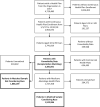The association between a history of anxiety or depression and utilization of diagnostic imaging
- PMID: 34252170
- PMCID: PMC8274845
- DOI: 10.1371/journal.pone.0254572
The association between a history of anxiety or depression and utilization of diagnostic imaging
Abstract
Objective: While prior research shows that mental illness is associated with lower utilization of screening imaging, little is known about how mental illness impacts use of diagnostic imaging, other than for screening. This study explores the association between a history of anxiety or depression in the prior year and utilization of diagnostic imaging.
Methods: Commercial and Medicare Advantage health plan claims from 2017 and 2018 from patients with plans from one national organization were extracted. Exclusions were made for patients without continuous plan enrollment. History of anxiety or depression was determined using 2017 claims, and downstream diagnostic imaging was determined using 2018 claims. Univariate associations were assessed with Chi-square tests. A matched sample was created using Coarsened Exact Matching, with history of mental illness serving as the treatment variable. Logistic regressions were used to calculate adjusted odds ratios, before and after matching, controlling for age, sex, urbanicity, local income, comorbidities, claims history, region, and health plan characteristics. Associations between mental illness and chest imaging, neuroimaging, and emergency department imaging were also evaluated.
Results: The sample included 2,381,851 patients before matching. Imaging was significantly more likely for patients with a history of anxiety (71.1% vs. 55.7%, P < .001) and depression (73.2% vs. 55.3%, P < .001). The adjusted odds of any imaging were 1.24 (95% confidence interval [CI]: 1.22-1.26) for patients with a history of anxiety, and 1.43 (CI: 1.41-1.45) for patients with a history of depression before matching, and 1.18 (CI: 1.16-1.20) for a history of anxiety and 1.33 (CI: 1.32-1.35) for a history of depression after matching. Adjusted analyses found significant, positive associations between mental illness and chest imaging, neuroimaging, and emergency department imaging both before and after matching.
Discussion: In contrast to prior findings on screening, anxiety and depression were associated with greater likelihood of diagnostic imaging within the population studied.
Conflict of interest statement
The authors have read the journal’s policy, and the authors of the study have the following competing interests to declare: AP and DF report an employment or consulting relationship with HealthHelp/WNS at the time the study was written. JWL and KJS report employment by Humana Inc. GC reports he is the sole owner of Schooner Strategies and serves as the President & CEO of RadSite, an accreditation organization that accredits imaging systems. AP additionally reports employment by Payer+Provider Syndicate, and stock ownership of Berkshire Hathaway, HCA Healthcare, Payer+Provider Syndicate, and Tenet Healthcare Corp. This does not alter our adherence to PLOS ONE policies on sharing data and materials. There are no patents, products in development or marketed products associated with this research to declare.
Similar articles
-
Noncardiac chest pain in the emergency department: the role of cardiac history, anxiety or depression and Type D personality.Eur J Cardiovasc Prev Rehabil. 2007 Apr;14(2):273-9. doi: 10.1097/HJR.0b013e32801da0fc. Eur J Cardiovasc Prev Rehabil. 2007. PMID: 17446807
-
Impact of mental illness on end-of-life emergency department use in elderly patients with gastrointestinal malignancies.Cancer Med. 2021 Mar;10(6):2035-2044. doi: 10.1002/cam4.3792. Epub 2021 Feb 23. Cancer Med. 2021. PMID: 33621438 Free PMC article.
-
A Description of Outcomes Experienced by Patients Whose Orders for Peripheral Artery Revascularization Were Reviewed by a Nondenial Prior Authorization Program.Vasc Endovascular Surg. 2022 May;56(4):393-400. doi: 10.1177/15385744211055911. Epub 2022 Feb 27. Vasc Endovascular Surg. 2022. PMID: 35225071
-
Mental illness in metropolitan, urban and rural Georgia populations.BMC Public Health. 2013 Apr 30;13:414. doi: 10.1186/1471-2458-13-414. BMC Public Health. 2013. PMID: 23631737 Free PMC article.
-
Sociodemographic Characteristics Associated With Hospitalizations for Anxiety and Depression Among Youth in Illinois.Acad Pediatr. 2020 Nov-Dec;20(8):1133-1139. doi: 10.1016/j.acap.2020.01.009. Epub 2020 Jan 27. Acad Pediatr. 2020. PMID: 32001372
Cited by
-
Effect of Serious Mental Illness on Surgical Consultation and Operative Management of Older Adults with Acute Biliary Disease: A Nationwide Study.J Am Coll Surg. 2023 Aug 1;237(2):301-308. doi: 10.1097/XCS.0000000000000710. Epub 2023 Apr 13. J Am Coll Surg. 2023. PMID: 37052311 Free PMC article.
References
-
- Health equity. World Health Organization 2017. https://www.who.int/topics/health_equity/en/ (accessed December 18, 2019).
-
- AAFP Policies on Health Equity Issues. AAFP 2017. https://www.aafp.org/patient-care/social-determinants-of-health/discrimi... (accessed December 18, 2019).


